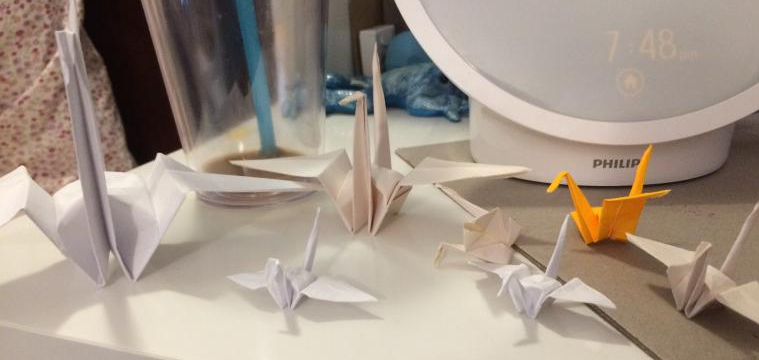千羽鶴 one thousand cranes
I also have an ongoing project where I fold origami cranes. I fold a lot of cranes! I don't know why! But here they are!

Cranium
If I was aiming for productivity,
I would fold paper planes instead.
I wish my goal wasn't productivity.

The Giantess crane named Betty
An Essay On Cranes
What is Senbazuru?
Senbazuru, literally ‘a thousand cranes,’ is the practice of folding a thousand cranes in order to have a long life, or to have a wish granted. Although the practice is often attributed to ‘Japanese legend,’ it is actually a relatively modern practice popularized by anti-nuclear advocacy. Sadako Sasaki was twelve years old when she was diagnosed with bone leukemia, and began folding a thousand cranes in an attempt to recover. The cancer was a result of exposure to the nuclear bomb at Hiroshima when she was two years old. Unfortunately, Sasaki never finished her one thousand, and she also never recovered, dying shortly after her diagnosis.
Origami, the Japanese art of paper folding, was once a very reserved and ceremonial ritual practice, performed scarcely due to the high cost of paper. When paper became much cheaper, origami lost much of its ceremonial meaning and becoming more of a schoolroom practice. The 1797 book Sen Bazuru Orikake detailed how to go about folding a thousand cranes and other origami patterns. It seems to have been a relatively niche practice before Sasaki’s case was picked up by anti-nuclear advocates and spread on a global scale. Today, it persists as a ceremonial practice in Japan, but is recognized as a symbol of hope across the globe, with notable senbazuru projects being established after September 11 and various natural disasters. Applicants aspiring to be astronauts in Japan must undertake the folding of a senbazuru to demonstrate discipline and mental fortitude (though this is likely an urban myth). A foundation established in Sasaki’s name continues to donate her original cranes to anti-nuclear and pacifist movements.
Works Cited
- Beser, Ari. “How Paper Cranes Became a Symbol of Healing in Japan.” National Geographic Society Newsroom, 28 August 2015. Accessed 19 Feb 2022, https://blog.nationalgeographic.org/2015/08/28/how-paper-cranes-became-a-symbol-of-healing-in-japan/
This is my one thousandth crane that I expended on a wish.


Some of my earliest cranes.




